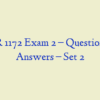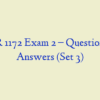Description
NURS 301 Exam 2 Focus Review – Nevada State College (63 Pages)
Exam 2 will cover Chapters: 10, 11, 12, 15, 16, 17, 18, 21, and 22,
CHAPTER 10
- Identify the types of family violence
- Identify the categories of family violence
- Describe how to prepare a physically and emotionally safe environment in which to interview and assess a client who has experienced domestic violence.
- Describe the technique to reassure the client who has been abused.
- Describe the domestic violent screening tools to identify victims of violence across the lifespan.
- Explain the danger assessment tool.
- Describe the interviewing techniques for assessing an abuse client
- Describe the components of the physical examination of a client who has been abused
- Discuss the importance of accurate documentation of physical assessment findings in clients who have experienced abuse.
- Explain the physical examination and documentation of the findings in an abused client.
CHAPTER 11
- Define culture and describe its basic characteristics.
- Describe the main purposes of assessing culture
- Describe how culture, genetics, and environment interact to affect health status.
- Discuss how cultural competence in the role of the nurse is necessary to make accurate assessments.
- Describe the National Standards for Culturally and inguisticallyAppropriate Services in Health Care
- Define stereotyping and ethnocentrism.
- Describe the parts of a cultural assessment.
- Describe modifications that need to be considered in a culturally competent interview
- Describe culture-bound syndromes and the cultural groups most likely to accept them as diseases.
- Differentiate between skills needed for a general routine cultural screening versus skills neededfor a focused cultural assessment.
Chapter 12
- Describe the difference between religion and spirituality.
- Explain spiritual assessment
- Discuss how understanding the client’s spirituality assists the nurse to understand the client’s decision making processes and support systems.
- Compare and contrast the nonformal and formal technique of spiritual assessment
- Discuss risk factors associated with spiritual distress.
- Differentiate between skills needed for general routine screening versus skills needed for focused specialty assessment of one’s spirituality and religious practices.
- Differentiate between normal and abnormal findings of a client’s spirituality and religious practices.
Chapter 15 Head and Neck:
- Discuss the internal jugular veins and carotid arteries and describe its location.
- Describe the functions of the thyroid gland and lymph nodes.
- Discuss the risk factors and risk reduction recommendations for Traumatic brain injuries in:
- Compare and contrast the differentiate types/character of headache
- Describe the preparation of a client for head and neck examination.
- Describe the correct technique to perform a physical assessment of the heart and neck.
- Discuss the significance of reported subjective symptoms in the head and neck.
- Compare and contrast the normal and abnormal findings in the head and neck examination.
- State abnormal findings of lymph nodes assessment.
- Describe the examination techniques to assess the head and neck.
- Differentiate between normal and abnormal objective and subjective findings related to the head and neck.
- Differentiate between normal and abnormal objective and subjective =
- Describe the older adult considerations in the physical examination of the head and neck./ Describe subjective and objective findings frequently seen when assessing the older client’s head and neck
- Discuss the signs and symptoms of hyperthyroidism and hypothyroidism.
- Discuss abnormal findings of head and neck (Acromegaly, Cushing syndrome, Hypothyroidism, Hyperthyroidism, Bell palsy)
CHAPTER 16 EYES
- Describe the visual fields and pathways
- Discuss risk factors for development of cataracts and glaucoma and ways to reduce the risk factors.
- Describe the preparation of the client for an eye examination
- Explain the use of the Snellen and E charts for evaluating a client’s distal and near vision
- Explain the method to perform confrontation test to evaluate peripheral visual fields
- Describe the technique of performing the cover test to evaluate extraocular muscle function
- Describe the technique to assess pupillary reaction to light and the process of accommodation
- Differentiate between normal and abnormal findings of the eye and vision.
- Dietary recommendations to decrease risk for developing age-related macular degeneration.
CHAPTER 17 EARS
- Describe the functions and structures of the ear.
- Differentiate between conductive hearing and sensorineural hearing loss
- Discuss the risk factors for hearing loss across cultures and discuss ways to reduce one’s risks.
- Review risk reduction ways to preserve hearing
- Risk factors for otitis media =
- Describe the technique of inspection and palpation of external ear structures
- Explain the technique in examination of the ear. =
- Describe the technique for performing a Weber test to assess type of hearing loss, Rinne Test, Romberg Test.
- Differentiate between normal and abnormal findings of the ear and hearing.
- Discuss the abnormalities of the external ear, ear canal, and the tympanic membrane
- Differentiate between general routine screening versus skills needed for focused or specialty assessment of the ear and hearing.
CHAPTER 18
- Discuss risk factors across cultures for oral cancer and list ways to reduce one’s risks.
- Explain the correct techniques to assess the mouth, throat, nose, and sinuses.
- Describe client preparation for examination of the mouth, throat, nose, and sinuses.
- Identify the equipment required for performing an assessment of the mouth, throat, nose, and sinuses
- Explain the techniques of inspection and palpation to assess the mouth, throat, nose, and sinuses =
- Describe the inspection of the throat for characteristics and position of the uvula, presence of gag reflex, grading of the tonsils, and tonsils and palate for color, size, condition, exudates, or lesions
- Explain the techniques to assess the sinuses through palpation and percussion.
- Explain the assessment of sinus through transillumination. Discuss abnormal findings.
- Differentiate between normal and abnormal findings of the mouth, throat, nose, and sinuses.
- Describe findings frequently seen when assessing the older client’s mouth, throat, nose, and sinuses. =
- Differentiate between general routine screening versus skills needed for focused or specialty assessment of the mouth, throat, nose, and sinuses.=
CHAPTER 21
- Describe the structure and function of the heart and neck vessels.
- Describe the various components of the electrical system of the heart. =
- Explain the phases of the electrocardiogram =
- Describe the diastolic and systolic phases of the cardiac cycle
- Discuss the risk factors for coronary heart disease (CHD) across cultures and ways to reduce one’s risks.
- Explain the correct techniques of inspection, auscultation, palpation, and percussion when performing physical assessment of the heart and neck vessels.
- Explain the normal heart sounds S1 and S2
- Describe the technique of assessment of jugular venous pulse and jugular venous pressure
- Differentiate between normal and abnormal findings of the heart and neck vessels.
- List the conditions that contribute to extra heart sounds or heart murmurs
- Describe the findings frequently seen when assessing the older client’s heart and neck vessels.
- Differentiate between general routine screening versus skills needed for focused or specialty assessment of the heart and neck vessels =
CHAPTER 22
- Describe the structure and the function of the blood vessels, including capillaries, and lymphatic circulation.
- Compare and contrast venous and arterial functions
- Discuss the risk factors associated with peripheral vascular disease (DVT, PAD, venous stasis)
- Explain the ways to reduce the risk factors associated with peripheral vascular disease
- Explain the technique of inspection and palpation of the arm size and venous pattern
- Describe the technique of inspection and palpation of the client’s legs for color, hair distribution, lesions or ulcers
- Explain the method of inspection of the client’s legs for varicosities and thrombophlebitis
- Differentiate between normal and abnormal findings of the peripheral vascular system.
- Describe the findings frequently seen with assessing the older client’s peripheral vascular system.
- Differentiate between general routine screening versus skills needed for focused or specialty assessment of the peripheral vascular system. =
- Explain the technique of palpation of client’s legs for edema, and skin temperature.




